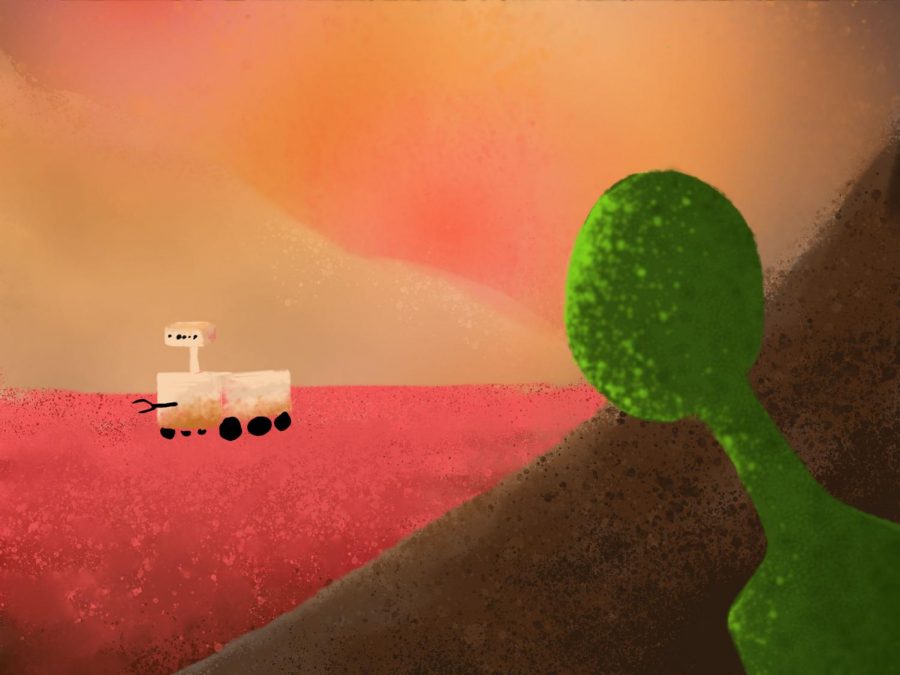Maybe There Is Space for You and Me (and a Couple Aliens)
WATCHING FROM AFAR This picture presents a very possible theory that many people believe in; aliens are out there and silently watching. Freshman David Adams comments, “If life more intelligent came to us, I’d be very scared. In history, those who approach always destroy.”
September 28, 2018
The controversy over the existence of alien life is something our world continues to ponder. In the past, our many attempts to find extraterrestrial life have failed, (or at least, that is what we have been told). Yet a surprising number of people still cling to the idea of aliens existing, readily open to accepting all the wildest conspiracy theories. Junior Owen Erickson believes “there’s some sort of life form out there.” However, we may be about to encounter some actual evidence if all goes well. Scientists appear to be planning their own methods of finding the answer to the question that has been plaguing us for decades.
According to NBC news, scientists plan to do this through the upcoming project: Systematic Underwater Biogeochemical Science and Exploration Analog. Project SUBSEA will involve two vehicles, the Hercules and the Argus, being sent down to the Lo Ihi seamount in Hawaii. The Lo Ihi seamount is an underwater volcano and is located in Big Island, where there is a network of hydrothermal vents. A variety of life was found within these vents, such as bacteria, tube worms and clams. Similar hydrothermal vents are thought to be on Enceladus, one of Saturn’s moons. Scientists hope to find some connection between the cultivation of life on Earth’s vents and on Saturn’s. The Lo Ihi seamount has even particularly been chosen to be studied because it is believed to have similar pressures and temperatures to Enceladus’ supposed vents. If any connection between the two is made, then it could open doors to discovering whether life is present in all parts of the universe. Jets of water had been observed on Enceladus’ surface in the south pole, which additionally hints at the possible discovery of vents. The moon’s ocean is expected to be teeming with organic compounds, based on Earth’s geological features. However, we do not yet have the technology or the knowledge to send a probe all the way to Saturn. Thus, it is crucial that we gather more information about the vents on Earth before proceeding. SUBSEA’s lead scientist, geologist Chris German, commented that eighty percent of the vents on Earth have not been explored yet, but we are all ready to start navigating the rest of the universe.
Since probes are being sent down to the Lo Ihi seamount, there will be a lot of human and robot interaction involved in the mission. The main goal is to get experienced with telepresence, so when scientists have to actually control robots in space from such a long distance away on Earth, they will be comfortable with it and be prepared enough to deal with potential problems. When we eventually send robots to remote locations in space, operating robots from Earth will be the cheaper and safer option. There will be no need to send astronauts and it will minimize contamination by microbes from Earth, which is beneficial for the area being studied and the data being collected. The increasing use of technology, which quite a few people have expressed concern over in the past years, appears to be useful. Freshman David Adams says, “I think tech is good but we should be cautious about artificial intelligence. A book I read outlines how even technooptomists see if AI goes wrong, it could lead to our possible extinction.” Junior Natalie Fortes says, “Although it’s helping us gain knowledge and spread it, it could soon overtake us and do what we do.”
Several students at Issaquah High believe in the possibility aliens may truly exist. However, even for the strongest believers out there, one cannot deny that there are a lot of aspects about aliens that still remain to be explained. For example, if there is extraterrestrial life, then why have they not found us? As NBC news explains, the Fermi paradox, proposed by Enrico Fermi in 1950, addresses exactly that. Logically, when it comes to sentient beings, colonization usually presents itself as a main goal to accomplish. So the supposed aliens out there would have colonized us by now. But Fermi offers some explanation as to why they might not have. He theorized that colonizing may be too expensive or that humans were seen as too primitive to afford bothering with. But his theory is not called the Fermi ‘paradox’ for nothing, because in it, as the Seti Institute points out, he also states there is no sign of alien life because aliens simply do not exist.
NBC news says Russian physicist A.A. Berezin claimed that aliens learned to travel between stars, and through expansion, wiped out everyone else. If the aliens, for whatever reason, left Earth alone, then why not leave a few of them behind to watch over all the humans? In response to that, Berezin said it would be hard for them to maintain communication with the rest of their species, but Berezin also said there may be an undetectable species out there anyhow, effectively contradicting his theory. As it turns out, most theories concerning aliens run into the problem of major plot holes and contradictory statements. Senior Roberto Focsa says, “Maybe aliens are more advanced and good at hiding.” Sophomore Sariah McIntyre theorizes, “They’re probably out there and they’re less or the same-level advanced as us, or have found us already.” Though all theories are valid, their myriad of faults play a lot into why there are so many skeptics. At the same time, to think humanity is the only sentient species in the whole universe seems a bit egotistical as well as unrealistic. Who is to say?
Overall, until we come across more concrete evidence, which we hope to through project SUBSEA, it is very difficult to make a decision about your stance on the topic. As special as we may believe ourselves to be, perhaps our unwavering hope for life out there goes beyond silly conspiracies. Maybe we hope that we are not all alone in a giant world we barely know anything about. After all, as the saying that can be found on thousands of T-shirts goes, ‘I believe in aliens, so maybe they believe in me.’






